Abstract
Recently several attempts to identify oxygen-derived radicals in whole cells by spin trapping and electron spin resonance have been reported by using 5,5-dimethyl-1-pyrroline-N-oxide as the spin trap. In the present study, the feasibility of this method is examined. Chinese hamster V79 cells and human erythrocytes served as the test systems, while OH radicals were generated by gamma radiolysis. Several spin traps were used to scavange the radicals and a distinction between exo- and endocellular ESR observable species was achieved using tri(oxalato) chromiate(III) as a line broadening agent. To distinguish between exo- and endocellular sites of radical formation, we studied the effects of high molecular weight scavengers (polyethylene glycols), which do not enter the cell. Various possible obstacles associated with trapping and detecting the radicals inside the cells were examined. The results indicate that the primary radicals react with the spin traps. However, these spin adducts decayed within the cells. Cellularly induced decay of 2-hydroxy-5,5-dimethyl-1-pyrrolidinyloxyl radical presented the major difficulty in detecting the endogenous radicals, and potential experimental approaches to overcome this difficulty are discussed.
Full text
PDF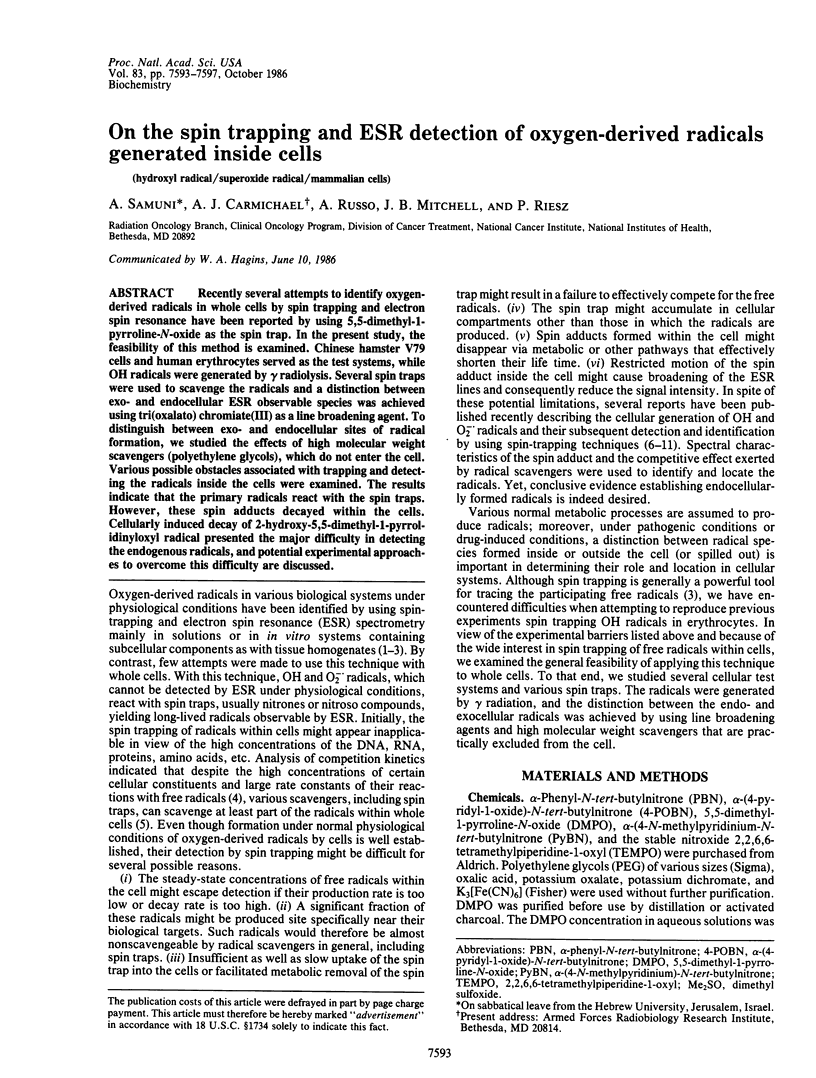
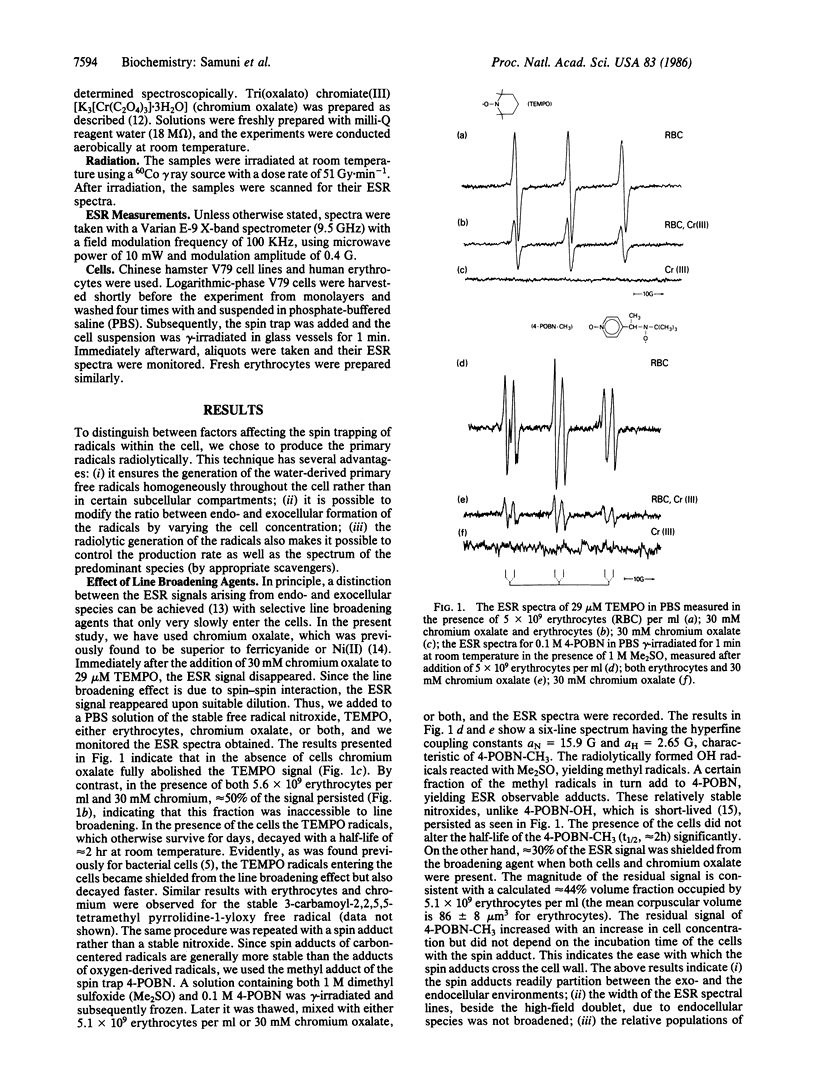
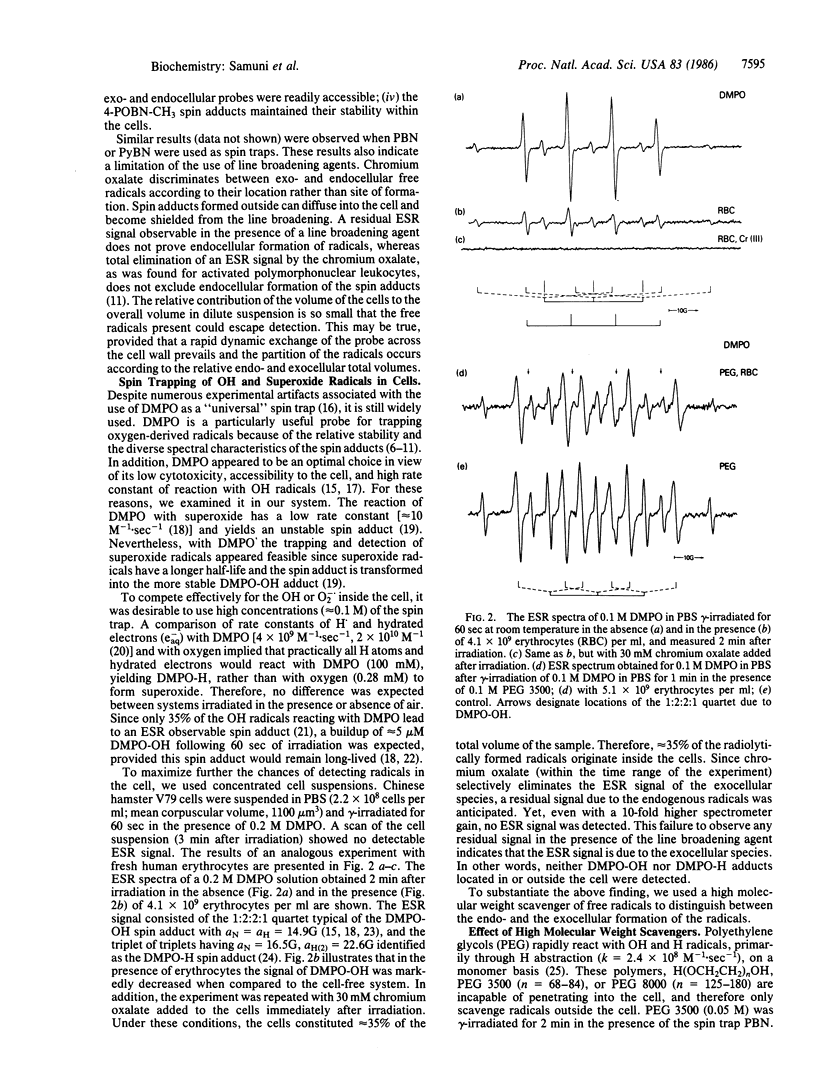
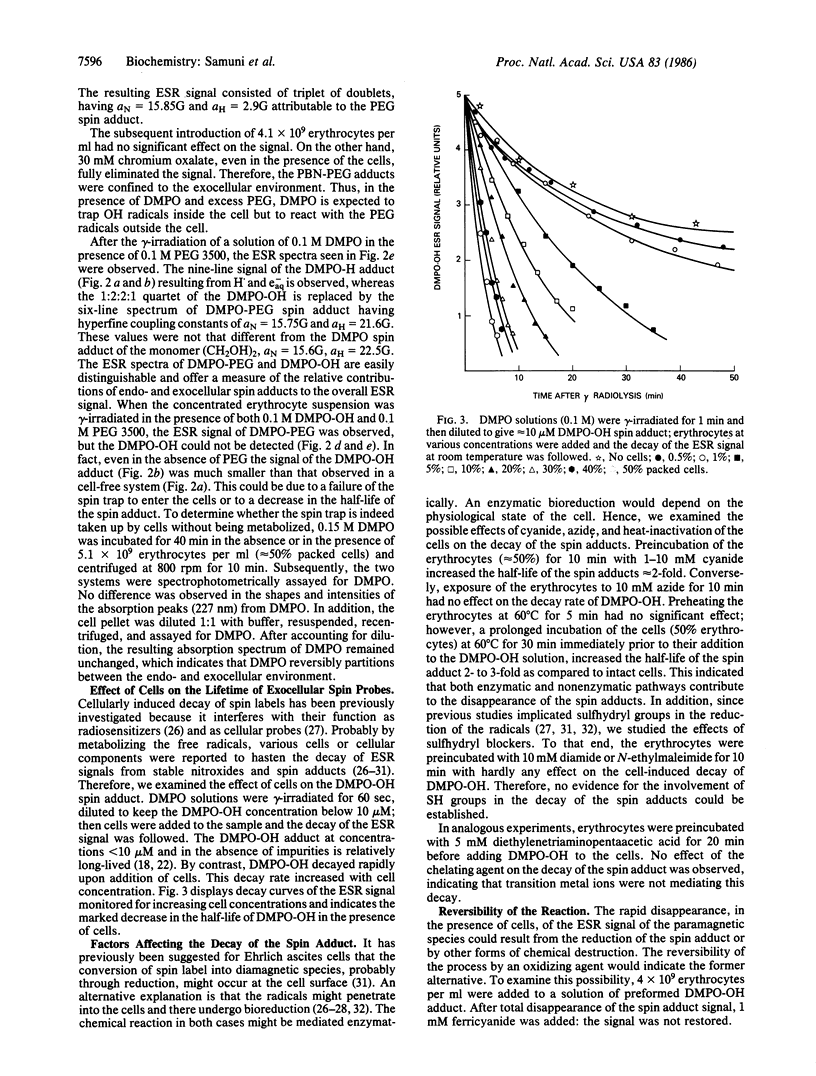
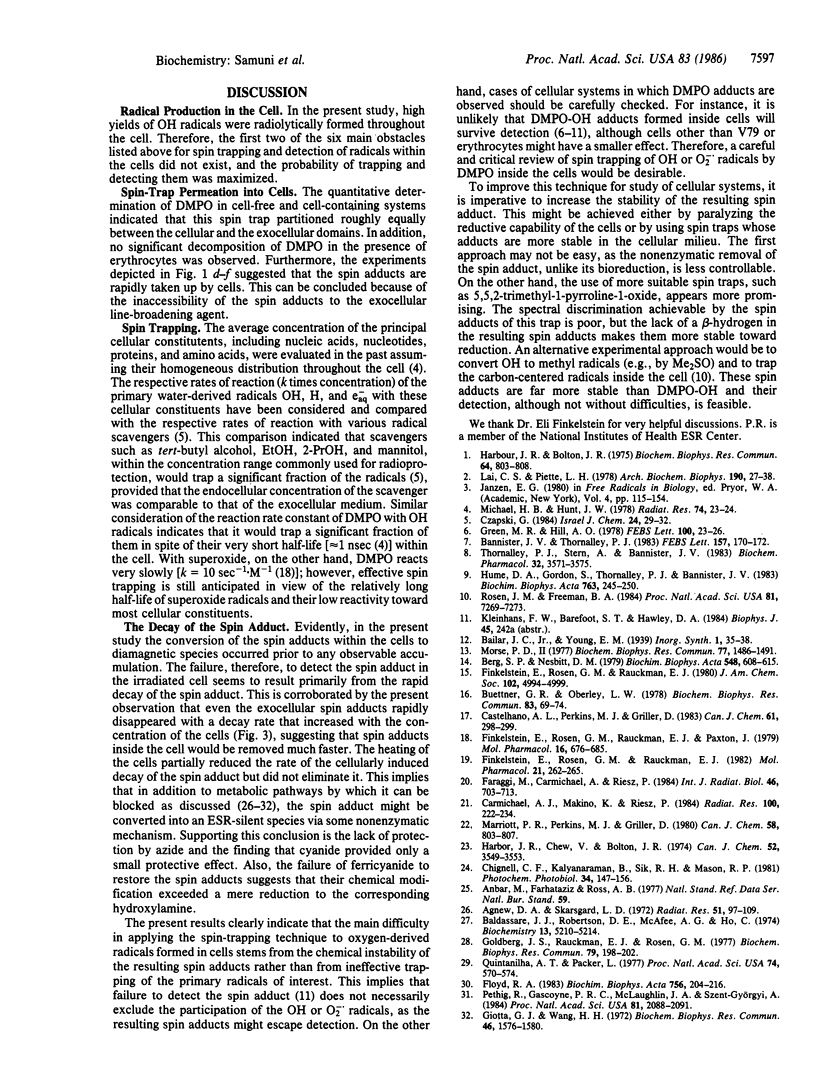
Selected References
These references are in PubMed. This may not be the complete list of references from this article.
- Agnew D. A., Skarsgard L. D. Sensitization of anoxic mammalian cells to radiation by triacetoneamine-N-oxyl. Effect of pre- and postirradiation treatment. Radiat Res. 1972 Jul;51(1):97–109. [PubMed] [Google Scholar]
- Baldassare J. J., Robertson D. E., McAfee A. G., Ho C. A spin-label study of energy-coupled active transport in Escherichia coli membrane vesicles. Biochemistry. 1974 Dec 3;13(25):5210–5214. doi: 10.1021/bi00722a025. [DOI] [PubMed] [Google Scholar]
- Bannister J. V., Thornalley P. J. The production of hydroxyl radicals by adriamycin in red blood cells. FEBS Lett. 1983 Jun 27;157(1):170–172. doi: 10.1016/0014-5793(83)81139-9. [DOI] [PubMed] [Google Scholar]
- Berg S. P., Nesbitt D. M. Chromium oxalate: a new spin label broadening agent for use with thylakoids. Biochim Biophys Acta. 1979 Dec 6;548(3):608–615. doi: 10.1016/0005-2728(79)90068-9. [DOI] [PubMed] [Google Scholar]
- Buettner G. R., Oberley L. W. Considerations in the spin trapping of superoxide and hydroxyl radical in aqueous systems using 5,5-dimethyl-1-pyrroline-1-oxide. Biochem Biophys Res Commun. 1978 Jul 14;83(1):69–74. doi: 10.1016/0006-291x(78)90398-4. [DOI] [PubMed] [Google Scholar]
- Carmichael A. J., Makino K., Riesz P. Quantitative aspects of ESR and spin trapping of hydroxyl radicals and hydrogen atoms in gamma-irradiated aqueous solutions. Radiat Res. 1984 Nov;100(2):222–234. [PubMed] [Google Scholar]
- Faraggi M., Carmichael A., Riesz P. OH radical formation by photolysis of aqueous porphyrin solutions. A spin trapping and e.s.r. study. Int J Radiat Biol Relat Stud Phys Chem Med. 1984 Dec;46(6):703–713. doi: 10.1080/09553008414551941. [DOI] [PubMed] [Google Scholar]
- Finkelstein E., Rosen G. M., Rauckman E. J., Paxton J. Spin trapping of superoxide. Mol Pharmacol. 1979 Sep;16(2):676–685. [PubMed] [Google Scholar]
- Finkelstein E., Rosen G. M., Rauckman E. J. Production of hydroxyl radical by decomposition of superoxide spin-trapped adducts. Mol Pharmacol. 1982 Mar;21(2):262–265. [PubMed] [Google Scholar]
- Floyd R. A. Hydroxyl free-radical spin-adduct in rat brain synaptosomes. Observations on the reduction of the nitroxide. Biochim Biophys Acta. 1983 Mar 31;756(2):204–216. doi: 10.1016/0304-4165(83)90093-4. [DOI] [PubMed] [Google Scholar]
- Giotta G. J., Wang H. H. Reduction of nitroxide free radicals by biological materials. Biochem Biophys Res Commun. 1972 Feb 25;46(4):1576–1580. doi: 10.1016/0006-291x(72)90788-7. [DOI] [PubMed] [Google Scholar]
- Goldberg J. S., Rauckman E. J., Rosen G. M. Bioreduction of nitroxides by Staphylococcus aureus. Biochem Biophys Res Commun. 1977 Nov 7;79(1):198–202. doi: 10.1016/0006-291x(77)90080-8. [DOI] [PubMed] [Google Scholar]
- Green M. R., Hill H. A., Okolow-Zubkowska M. J., Segal A. W. The production of hydroxyl and superoxide radicals by stimulated human neutrophils- measurements by EPR spectroscopy. FEBS Lett. 1979 Apr 1;100(1):23–26. doi: 10.1016/0014-5793(79)81123-0. [DOI] [PubMed] [Google Scholar]
- Harbour J. R., Bolton J. R. Superoxide formation in spinach chloroplasts: electron spin resonance detection by spin trapping. Biochem Biophys Res Commun. 1975 Jan 2;64(3):803–807. doi: 10.1016/0006-291x(75)90118-7. [DOI] [PubMed] [Google Scholar]
- Hume D. A., Gordon S., Thornalley P. J., Bannister J. V. The production of oxygen-centered radicals by bacillus-Calmette-Guerin-activated macrophages. An electron paramagnetic resonance study of the response to phorbol myristate acetate. Biochim Biophys Acta. 1983 Oct 25;763(3):245–250. doi: 10.1016/0167-4889(83)90131-3. [DOI] [PubMed] [Google Scholar]
- Lai C. S., Piette L. H. Spin-trapping studies of hydroxyl radical production involved in lipid peroxidation. Arch Biochem Biophys. 1978 Sep;190(1):27–38. doi: 10.1016/0003-9861(78)90250-3. [DOI] [PubMed] [Google Scholar]
- Michaels H. B., Hunt J. W. A model for radiation damage in cells by direct effect and by indirect effect: a radiation chemistry approach. Radiat Res. 1978 Apr;74(1):23–34. [PubMed] [Google Scholar]
- Morse P. D., 2nd Use of the spin label tempamine for measuring the internal viscosity of red blood cells. Biochem Biophys Res Commun. 1977 Aug 22;77(4):1486–1491. doi: 10.1016/s0006-291x(77)80146-0. [DOI] [PubMed] [Google Scholar]
- Pethig R., Gascoyne P. R., McLaughlin J. A., Szent-Györgyi A. Interaction of the 2,6-dimethoxysemiquinone and ascorbyl free radicals with Ehrlich ascites cells: a probe of cell-surface charge. Proc Natl Acad Sci U S A. 1984 Apr;81(7):2088–2091. doi: 10.1073/pnas.81.7.2088. [DOI] [PMC free article] [PubMed] [Google Scholar]
- Quintanilha A. T., Packer L. Surface localization of sites of reduction of nitroxide spin-labeled molecules in mitochondria. Proc Natl Acad Sci U S A. 1977 Feb;74(2):570–574. doi: 10.1073/pnas.74.2.570. [DOI] [PMC free article] [PubMed] [Google Scholar]
- Rosen G. M., Freeman B. A. Detection of superoxide generated by endothelial cells. Proc Natl Acad Sci U S A. 1984 Dec;81(23):7269–7273. doi: 10.1073/pnas.81.23.7269. [DOI] [PMC free article] [PubMed] [Google Scholar]
- Thornalley P. J., Stern A., Bannister J. V. A mechanism for primaquine mediated oxidation of NADPH in red blood cells. Biochem Pharmacol. 1983 Dec 1;32(23):3571–3575. doi: 10.1016/0006-2952(83)90305-2. [DOI] [PubMed] [Google Scholar]


